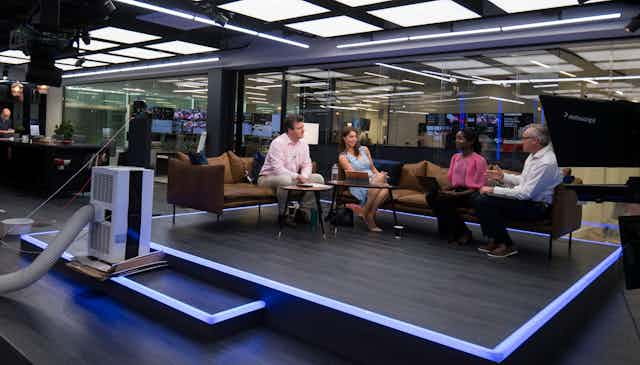Launch night on the UK’s latest broadcast news network, GB News, was a rough night to be a sound operator. The much-trailed channel went on-air at 8pm on Sunday June 13 with a mission statement delivered by its company chairman and principal political presenter Andrew Neil.
Unfortunately, his sound was “out of sync”. The audio that viewers heard at home ran slightly behind the movement of his lips, which was disconcerting for viewers. A corrected version was later uploaded to Twitter.
It was not the only technical issue to blight the launch night. Microphones failed to work, mistimed programmes were cut short by ad breaks, and presenters seemed unsure which camera to look at or when they were supposed to speak.
Delivered from a set that appeared poorly lit and without the slick production skills we have become accustomed to on television news, it prompted viewers to snipe on Twitter about “student television”.
Some newspaper reviewers mocked the gap between its lofty ambitions and poor application.
On Twitter, veteran presenter Alastair Stewart took some of the critics to task.
Television news is a team effort. The programmes viewers see at home are made by producers, directors, sound people and designers. It is an enormously complex logistical operation. Launching a new channel involves people physically building studios and infrastructure at the same time as training programme teams on new production technology. The expertise needed to keep a channel smoothly transmitting takes time to build up.
Channel launches are always fraught events, technology does not always keep up with the management’s ambitious editorial visions. When I was a producer at ITN, I worked on the launch of its rolling news channel. With a new computerised playout system it was ground-breaking, removing the need to use videotape in programme production.
But the newly developed digital video servers were unreliable. They would frequently crash, threatening to take the channel entirely off-air. When it happened, the director would ask the presenter to read a standby script and play a long back-up report while the IT team rebooted the server. On one memorable occasion a presenter who had knocked her paper copy of the script off the desk had to duck out of shot and, while still live on-air, scrabble around on the floor to retrieve it.
Do not adjust your set
GB News is not the first news service to face criticism for launch problems. Even well-funded operations such as Al Jazeera English have had issues. It was months late on-air because of behind-the-scenes technical faults. And to compound the problem the channel changed its name from Al Jazeera International just before it was due to go live. Channel 4 News, Sky News and many more have had technical challenges to overcome before the procedures of broadcasting become ingrained.
For television professionals, “production value” – the technical aspects of programme creation – is important. Flawless presentation is associated with professionalism and quality. For the audience, these things seem to have changed over time.
Back in 2011, a study by US media scholars R Glenn Cummins and Todd Chambers found viewers do recognise variation in production value and tend to judge stories high in production value as more credible than identical stories that are low in production value.
But audiences have grown used to seeing eye-witness video shot on phones and, during the pandemic, interviews filmed on Zoom or Skype. During the Iraq war when phone-quality video was starting to be used on television news for the first time, some TV news engineers were worried that the regulator would act against the use of such low production quality video. Changes in audience taste and improvements in technology have made such concerns irrelevant.

But that is not to say that there is not value in a well-produced programme and a well-designed set. Look at the way in which LBC has pioneered visualised radio for social media producing high-quality clips of its marquee presenters, including James O'Brien and Nick Ferrari, for consumption on platforms such as Facebook and Twitter. Brightly lit studios, with prominent branding, make it appealing to watch as well as listen to. Talk Radio and Times Radio have quickly learned the same lessons. GB News also clearly hopes to maximise social media impact as it builds a loyal audience.
GB News has gone from an idea to a channel during the pandemic. Its view of polemical television is not one that appeals to everyone, but to condemn it for technical mistakes during the first days on-air is unfair and short-sighted. As the days turn to weeks and months it is likely to resolve the technical problems, and see its presenters and producers grow in confidence.
It faces many challenges in the months ahead as it tries to develop a different style of profitable TV news. Getting right the technical aspects of production seems one of the easier ones to overcome.

